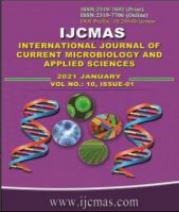


 National Academy of Agricultural Sciences (NAAS)
National Academy of Agricultural Sciences (NAAS)

|
PRINT ISSN : 2319-7692
Online ISSN : 2319-7706 Issues : 12 per year Publisher : Excellent Publishers Email : editorijcmas@gmail.com / submit@ijcmas.com Editor-in-chief: Dr.M.Prakash Index Copernicus ICV 2018: 95.39 NAAS RATING 2020: 5.38 |
Biological control is a living weapon and an excellent strategy over chemical control. Opisina arenosella Walker is one of the serious and endemic pests of coconut in India. The O. arenosella is attacked by many entomophagous insects during its developmental stages. Among them, G. nephantidis is a gregarious ecto-larval parasitoid and responsible for the reduction in the population pest under field conditions. There is a continuous demand for G. nephantidis throughout the coconut growing area. Generally, Corcyra cephalonica is used for mass rearing of G. nephantidis. While Galleria mellonella is used for rearing various entomophagous insects. To find out best laboratory host for mass rearing of G. nephantidis in laboratory, we investigated comparative parasitic potential of G. nephantidis on G. mellonella and C. cephalonica. The results revealed that, G. nephantidis female paralyzed the larva of C. cephalonica and G. mellonella within 2 to 3 hours after release. The average number of larvae parasitized by G. nephantidis were 6.10±1.07 and 5.85±0.88 on G. mellonella and C. cephalonica, respectively. The average clutch size was 12.65±3.31 and 12.45±3.31 eggs per of larva G. mellonella and C. cephalonica, respectively. There was a highly significant (t=11.62**) variation observed in the survival of G. nephantidis when reared on G. mellonella and C. cephalonica. Significantly highest survival of G. nephantidis observed on C. cephalonica (42.98±6.87%) than G. mellonella (18.58±6.41%). Among both the hosts, C. cephalonica could be utilized for the mass production of G. nephantidis.
 |
 |
 |
 |
 |